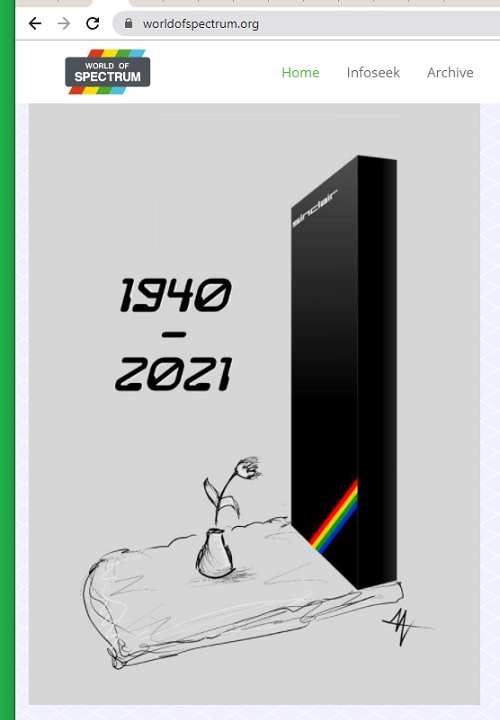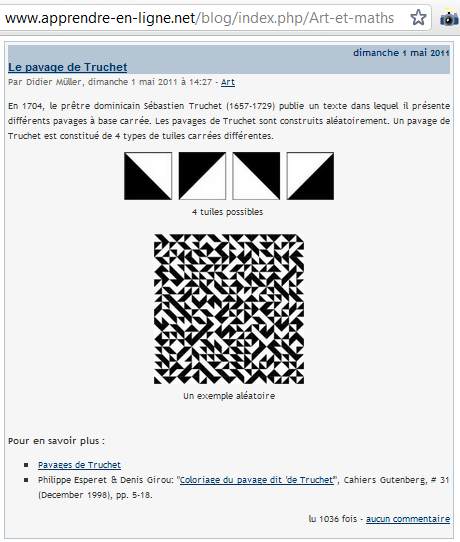See also related material.
Tuesday, July 11, 2023
Saturday, September 18, 2021
A Tombstone* for Sinclair
In memory of Sir Clive Sinclair…
… who reportedly "died at home in London on Thursday morning" —
From a Log24 post of May 25, 2005 —
"We will go to Asgard...now," he said.
Friday, November 1, 2024
The Aida Recode: Volano al raggio dell’eterno dì
Thursday, October 3, 2024
Wednesday, October 2, 2024
“The serpent’s eyes shine . . .” — Song lyric by Don Henley
In memory of British author Clive Sinclair,* who reportedly
died on March 5, 2018 —

* Sinclair was "born into a Jewish family originally named Smolensky."
— Wikipedia
Tuesday, January 9, 2024
For Professional Hallucinators
The hallucinations of chatbots have a way to go
to catch up with those of their human counterparts . . .

See Sinclair in this journal.
Saturday, January 15, 2022
Superimposed Figures
A David Mamet line from last night's 11:02 PM ET post —
"Something to do with an early computer." This suggests . . .

"The metaphor for metamorphosis no keys unlock." — Cullinane, 1986
See as well a different Franz.
Monday, September 20, 2021
Doppelt Leben: A Special Charm
Wer liest, lebt doppelt
Arbeiten mit Ganzschriften im Religionsunterricht
Meist werden Text (auszüge) im RU eingesetzt.
Dabei hat das Erschließen von 'Ganzschriften'
einen besonderen Reiz….
— KI-Nr.-04_Wer-liestlebt-doppelt-
Arbeit-mit-Ganzschriften-08.10.20.pdf
Who reads, lives twice
Working with full scripts in religious education
Most of the time, text (excerpts) are used in RU.
The opening up of 'whole scripts' has
a special charm….
— Google Translate

The social-media version:
Getting Personal


"At age eighteen, Ensslin spent a year in the United States,
where she attended high school in Warren, Pennsylvania.
She graduated in the Honor Group at Warren High School
in 1959." — Wikipedia
See also posts tagged Crux in this journal.
Some context —

Sunday, September 19, 2021
Risen
Last Sunday:
A week later:

From a recent Instagram story —

A related ghost writer —
Update of 11:22 PM ET the same day (Sept. 19, 2021) —

"The metaphor for metamorphosis no keys unlock." — Cullinane, 1986
See as well a different Franz.
Saturday, January 12, 2013
There Will Be Aaron
I learned this afternoon of a significant death:

See a NY Times obit and "RIP, Aaron Swartz."
The latter quotes Swartz himself:
"Obviously shades of Sinclair here…"
Related material:
-
Sinclair's shade in a recent Daniel Day-Lewis film—
"Bakersfield’s close-up in 'There Will Be Blood'"— - Friday morning's post Grapevine Hill
- and this morning's post Abstract.
Not so related:
-
This journal on the date— Feb. 23, 2010— of
Shellie Branco's post, linked to above, on Bakersfield,
Upton Sinclair, Taft CA, and "Blood"…A post titled Fish Story
on secular vocabulary and San Diego.
(Content last updated 4:16 EST Jan. 12, 2013.)
Wednesday, June 13, 2012
State of the Art
The new June/July issue of the AMS Notices
on a recent Paris exhibit of art and mathematics—
Mathématiques, un dépaysement soudain
Exhibit at the Fondation Cartier, Paris
October 21, 2011–March 18, 2012
… maybe walking
into the room was supposed to evoke the kind of
dépaysement for which the exhibition is named
(the word dépaysement refers to the sometimes
disturbing feeling one gets when stepping outside
of one’s usual reference points). I was with
my six-year-old daughter, who quickly gravitated
toward the colorful magnetic tiles on the wall that
visitors could try to fit together. She spent a good
half hour there, eventually joining forces with a
couple of young university students. I would come
and check on her every once in a while and heard
some interesting discussions about whether or not
it was worth looking for patterns to help guide the
placing of the tiles. The fifteen-year age difference
didn’t seem to bother anyone.
The tiles display was one of the two installations
here that offered the visitor a genuine chance to
engage in mathematical activity, to think about
pattern and structure while satisfying an aesthetic
urge to make things fit and grow….
The Notices included no pictures with this review.
A search to find out what sort of tiles were meant
led, quite indirectly, to the following—
The search indicated it is unlikely that these Truchet tiles
were the ones on exhibit.
Nevertheless, the date of the above French weblog post,
1 May 2011, is not without interest in the context of
today's previous post. (That post was written well before
I had seen the new AMS Notices issue online.)
Saturday, July 12, 2003
Saturday July 12, 2003
Before and After
From Understanding the (Net) Wake:
| 24 A.
Joyce shows an understanding of the problems that an intertextual book like the Wake poses for the notion of authorship. |
G. H. Hardy in A Mathematician’s Apology:
“We do not want many ‘variations’ in the proof of a mathematical theorem: ‘enumeration of cases,’ indeed, is one of the duller forms of mathematical argument. A mathematical proof should resemble a simple and clear-cut constellation, not a scattered cluster in the Milky Way.
A chess problem also has unexpectedness, and a certain economy; it is essential that the moves should be surprising, and that every piece on the board should play its part. But the aesthetic effect is cumulative. It is essential also (unless the problem is too simple to be really amusing) that the key-move should be followed by a good many variations, each requiring its own individual answer. ‘If P-B5 then Kt-R6; if …. then …. ; if …. then ….’ — the effect would be spoilt if there were not a good many different replies. All this is quite genuine mathematics, and has its merits; but it just that ‘proof by enumeration of cases’ (and of cases which do not, at bottom, differ at all profoundly*) which a real mathematician tends to despise.
* I believe that is now regarded as a merit in a problem that there should be many variations of the same type.”
(Cambridge at the University Press. First edition, 1940.)

Brian Harley in Mate in Two Moves:
“It is quite true that variation play is, in ninety-nine cases out of a hundred, the soul of a problem, or (to put it more materially) the main course of the solver’s banquet, but the Key is the cocktail that begins the proceedings, and if it fails in piquancy the following dinner is not so satisfactory as it should be.”
(London, Bell & Sons. First edition, 1931.)
Wednesday, March 19, 2003
Wednesday March 19, 2003
A Look at the Rat
In memory of Herbert Aptheker, theoretician of the American Communist Party, who died on St. Patrick’s Day, 2003 —
From The New Yorker, issue dated March 24, 2003, Louis Menand on Edmund Wilson’s To the Finland Station:
“Wilson did know what was going on in the Soviet Union in the nineteen-thirties, as his pages on Stalin in To the Finland Station make clear. The problem wasn’t with Stalin; the problem was with Lenin, the book’s ideal type of the intellectual as man of action. Wilson admitted that he had relied on publications controlled by the Party for his portrait of Lenin. (Critical accounts were available; for example, the English translation of the émigré Mark Landau-Aldanov’s Lenin was published, by Dutton, in 1922.) Lenin could create an impression of selfless humanitarianism; he was also a savage and ruthless politician—a ‘pail of milk of human kindness with a dead rat at the bottom,’ as Vladimir Nabokov put it to Wilson in 1940, after reading To the Finland Station. In the introduction to the 1972 edition, Wilson provided a look at the rat. He did not go on to explain in that introduction that the most notorious features of Stalin’s regime—the use of terror, the show trials, and the concentration camps—had all been inaugurated by Lenin. To the Finland Station begins with Napoleon’s betrayal of the principles of the French Revolution; it should have ended with Lenin’s betrayal of European socialism.”
From Herbert Aptheker, “More Comments on Howard Fast“:
“We observe that in the list of teachers whom Howard Fast names as most influential in his own life there occur the names of fourteen individuals from Jefferson to Bernard Shaw, Upton Sinclair to Marx, Douglass to Engels, but there is no room for Lenin.
He is, I think, an important teacher, too; indeed, in my view, Lenin is the greatest figure in the whole galaxy of world revolutionary leaders. He is, certainly, the greatest analyzer of and fighter against imperialism.”
For more on Howard Fast, see my entry
“Death Knell” of March 13, 2003.
For a look at the pail of milk, see
the New Yorker cover in Geometry for Jews.
For a more cheerful look at geometry
on this St. Joseph’s Day, see
Harry J. Smith’s
“There is such a thing as a tesseract.”
— A Wrinkle in Time










